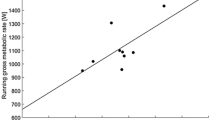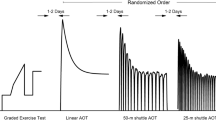Abstract
The aim of this study was to determine the effect of cycle intensity on subsequent running performance and combined cycle–run (CR) performance. Seven triathletes undertook a cycling graded exercise test to exhaustion, an isolated 500-kJ cycle time trial (CTT) and an isolated 5-km running time trial. Then they performed a series of CR tests, at various cycle intensities, followed by an all-out, 5-km run. The CR tests were separated into four categories based on the percentage of the CTT at which the cycle was performed (CR 81–85%, CR 86–90%, CR 91–95%, and CR 96–100%). Running performance was slower during CR 96–100% compared to CR 81–85% and CR 86–90% (20:45 ± 1:19 vs. 19:56 ± 0:40 and 19:46 ± 0:49 min; P < 0.05), but not CR 91–95% (20:19 ± 1:08 min; P > 0.05). CR performance was maximised during CR 96–100% when compared to CR 81–85, CR 86–90 and CR 91–95% (56:37 ± 4:04 vs. 62:40 ± 5:30, 59:53 ± 4:41 and 58:29 ± 4:40 min; P < 0.05). The results suggest that combined cycle and run performance is maximised when the cycle is completed at the highest sustainable intensity.



Similar content being viewed by others
References
Bernard T, Vercruyssen F, Grego F, Hausswirth C, Lepers R, Vallier JM, Brisswalter J (2003) Effect of cycling cadence on subsequent 3-km running performance in well trained triathletes. Br J Sports Med 37:154–158
Bishop D, Jenkins DG, McEniery M, Carey MF (2000) The relationship between plasma lactate parameters and muscle characteristics in female cyclists. Med Sci Sports Exerc 32(3):1088–1093
Chwalbinska-Moneta J, Robergs RA, Costill DL, Fink WJ (1989) Threshold for muscle lactate accumulation during progressive exercise. J Appl Physiol 66:2710–2716
Danner T, Plowman SA (1995) Running economy following an intense cycling bout in female duathletes and triathletes. Women Sport Phys Activity J 4:29–39
de Koning JJ, Bobbert MF, Foster C (1999) Determination of optimal pacing strategy in track cycling with an energy flow model. J Sci Med Sport 2:266–277
De Vito G, Bernardi M, Sproviero E, Figura F (1995) Decrease of endurance performance during Olympic triathlon. Int J Sports Med 16:24–28
Dengel DR, Flynn MG, Costill DL, Kirwan JP (1989) Determinants of success during triathlon competition. Res Q Exerc Sport 60:234–238
Foster C, Snyder AC, Thompson NN, Green MA, Foley M, Schrager M (1993) Effect of pacing strategy on cycle time trial performance. Med Sci Sports Exerc 25:383–388
Fukuba Y, Whipp BJ (1999) A metabolic limit on the ability to make up for lost time in endurance events. J Appl Physiol 87:853–861
Gottschall JS, Palmer BM (2000) Acute effects of cycling on running step length and step frequency. J Strength Cond Res 14:97–101
Guezennec CY, Vallier JM, Bigard AX, Durey A (1996) Increase in energy cost of running at the end of a triathlon. Eur J Appl Physiol Occup Physiol 73:440–445
Hausswirth C, Bigard AX, Berthelot M, Thomaidis M, Guezennec CY (1996) Variability in energy cost of running at the end of a triathlon and a marathon. Int J Sports Med 17:572–579
Hausswirth C, Lehenaff D, Dreano P, Savonen K (1999) Effects of cycling alone or in a sheltered position on subsequent running performance during a triathlon. Med Sci Sports Exerc 31:599–604
Hue O, Le Gallais D, Chollet D, Boussana A, Prefaut C (1998) The influence of prior cycling on biomechanical and cardiorespiratory response profiles during running in triathletes. Eur J Appl Physiol Occup Physiol 77:98–105
Hue O, Le Gallais D, Boussana A, Chollet D, Prefaut C (1999) Ventilatory responses during experimental cycle–run transition in triathletes. Med Sci Sports Exerc 31:1422–1428
Kreider RB, Cundiff DE, Hammett JB, Cortes CW, Williams KW (1988) Effects of cycling on running performance in triathletes. Ann Sports Med 3:220–225
Lepers R, Theurel T, Hausswirth C, Bernard T (2008) Neuromuscular fatigue following constant versus variable-intensity endurance cycling in triathletes. J Sci Med Sport 11(4):381–389
Millet GP, Bentley DJ (2004) The physiological responses to running after cycling in elite junior and senior triathletes. Int J Sports Med 25:191–197
Nakamaru Y, Schwartz A (1972) The influence of hydrogen ion concentration on calcium binding and release by skeletal muscle sarcoplasmic reticulum. J Gen Physiol 59:22–32
Palmer GS, Dennis SC, Noakes TD, Hawley JA (1996) Assessment of the reproducibility of performance testing on an air-braked cycle ergometer. Int J Sports Med 17:293–298
Schabort EJ, Killian SC, St Clair Gibson A, Hawley JA, Noakes TD (2000) Prediction of triathlon race time from laboratory testing in national triathletes. Med Sci Sports Exerc 32:844–849
Vercruyssen F, Brisswalter J, Hausswirth C, Bernard T, Bernard O, Vallier J-M (2002) Influence of cycling cadence on subsequent running performance in triathletes. Med Sci Sports Exerc 34:530–536
Author information
Authors and Affiliations
Corresponding author
Additional information
Communicated by Jean-René Lacour.
Rights and permissions
About this article
Cite this article
Suriano, R., Bishop, D. Combined cycle and run performance is maximised when the cycle is completed at the highest sustainable intensity. Eur J Appl Physiol 110, 753–760 (2010). https://doi.org/10.1007/s00421-010-1547-y
Accepted:
Published:
Issue Date:
DOI: https://doi.org/10.1007/s00421-010-1547-y




